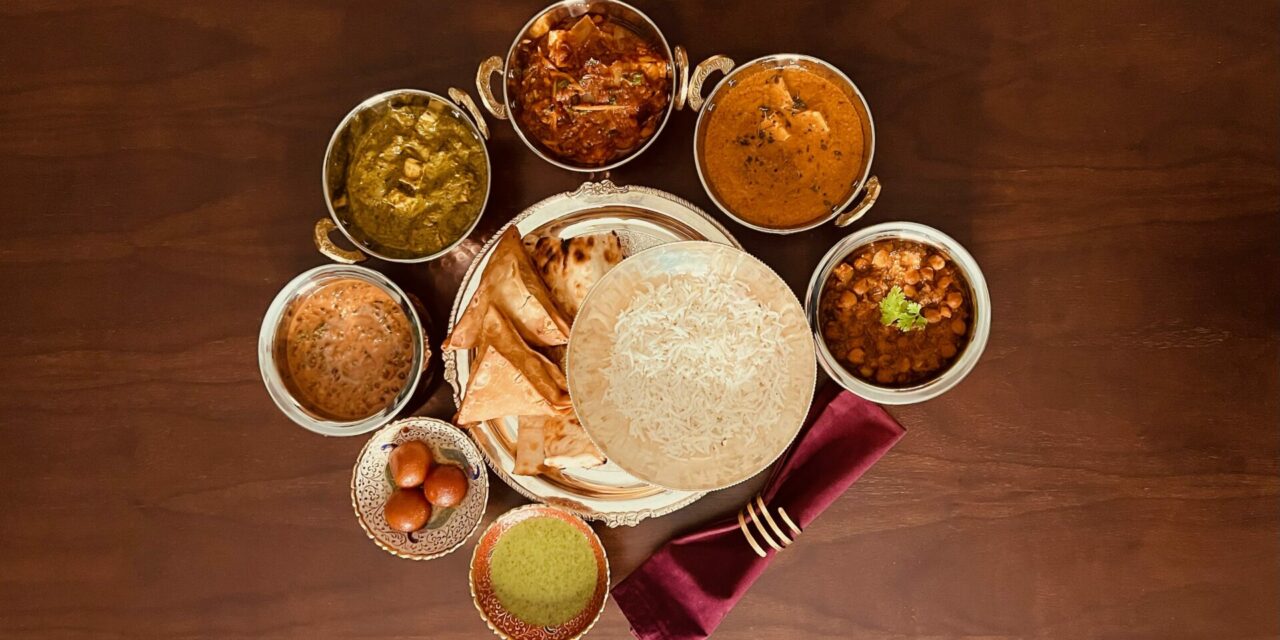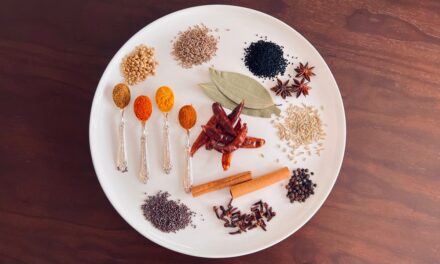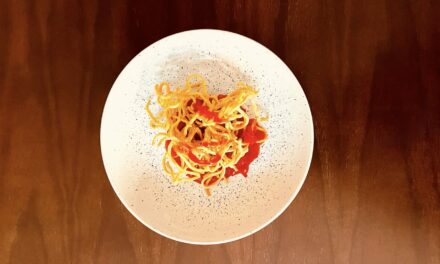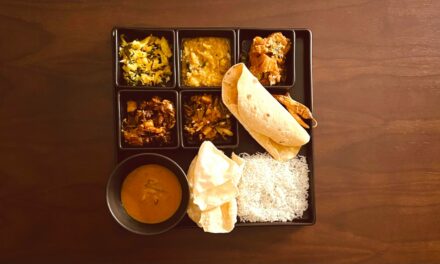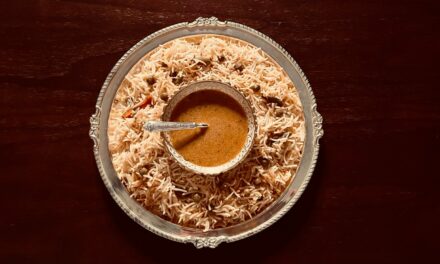Last week, in the first instalment of this series, I suggested that pairing wine with South Asian cuisine can be an exciting exercise filled with novelty and adventure. Infused with numerous spices and herbs and containing within it a great deal of textural diversity, North Indian food presents a wonderful starting point for exploring this potential.
In my experience, I have found the following broad principles or guidelines, if you will, helpful when trying to pair wine with this cuisine:
- To Mirror or Contrast? Of the two broad approaches to pairing food and wine, focussing on contrasting flavours and structural components is more likely to produce a successful match with most North Indian food. The flavours in the food are usually so powerful that they do not need further amplification. What wine can add to the meal is refreshing acidity, palate-cleansing tannins, and new flavours, such as ripe or dried fruit. There are some notable exceptions to this that I will touch upon where applicable.
- Structure: When pairing wine with North Indian food, the wine’s structure is the single most important factor. Wines with bright acidity refresh the palate and cut through the fat, oil, and/or cream that is present in many of the sauces. Lively acidity also complements the tanginess of food made with a souring agent, such as tomato or lemon. Similarly, a hint of sweetness in the wine can complement slightly sweet sauces; it can also balance heat from spices. In contrast, higher alcohol wines accentuate the heat from chillies, a positive development for some people, and a negative one for others.
- Intensity: The intensity of the wine is another key factor to consider; bolder wines with concentrated flavours stand up to spices and other strong flavours in the food.
- Fruit Versus Non-Fruit Flavours: As a rule, fruit-focussed wines pair well with spice-infused foods. Both juicy, ripe fruit profiles and tangy, tart ones have the potential to work with North Indian food. What is key is that fruit flavours take centre stage on the palate.
- Sweet Sauces: The issue of sweetness is so important in the context of many North Indian foods that it merits special attention. Many North Indian sauces are distinctly sweet (examples include shahi paneer, navratan korma, and paneer makhani). This sweetness can make a wine appear thin, astringent, and bitter. It can also mute fruit flavours in the wine, making them appear lean and subdued. In my experience, when trying to pair wine with sweet sauces, the best approach is to pick wines with robust, ripe fruit flavours. As noted above, a bit of residual sugar in the wine can also help. That said, generally, sweetness alone cannot rescue a wine served with a sweet and spicy sauce if it lacks ripe, lush fruit flavours.
- To Oak or Not to Oak: The extent to which oak plays a role in the flavour profile of the wine is also relevant. Wines with distinctive bitter oak flavours (like smoke, cocoa, and coffee) can sometimes clash with slightly sweet tomato-based and/or nutty, creamy sauces. These wines tend to pair better with food grilled in a tandoor, a staple in North Indian cuisine (here, the principle of mirroring flavours in wine and food comes into play).
- Service Temperature: This may be obvious to some, but an important and simple way to enhance the interaction between spicy food and wine is to chill the wine. In my experience, in addition to cooling white, sparkling, and rosé wines, red wines should also be served lightly chilled or at cellar temperature in order to complement the heat and richness of the food.
With these general principles in mind, let us explore some quintessential examples of North Indian cuisine!

The Food
Considering the diversity of North Indian food, I will focus on a small cross-section of the cuisine here. My goal is to articulate an approach to pairing wine and North Indian food that can be used as a starting point for further experimentation.
Most restaurants that style themselves as generically “Indian” in North America offer some or all of the following: paneer tikka, dal makhani, kadai paneer, malai kofta, shahi paneer, paneer butter masala, and navratan korma. These are rich, opulent foods that are also commonly served at dinner parties. In contrast, saag paneer, rajma chawal, and chana/chole masala are examples of classic comfort foods. Finally, fried snacks like samosas are often enjoyed in the mid-afternoon in homes, restaurants, and cafes all over the world.
Thinking of these foods in terms of broad clusters is useful:
-
- Rich, tomato and onion-based sauces that are sometimes slightly sweet like paneer tikka masala, paneer makhani, vegetable jalfrezi, and kadai paneer.
- Opulent creamy sauces like shahi paneer, malai kofta, and mushroom masala.
- Spice-infused lentil or legume-based foods like dal makhani, rajma, and chole.
- Preparations that are defined by vegetal/vegetable flavours like saag paneer and navratan korma.
- Dry, fried foods like pakoras or samosas.
- Dry foods grilled in a tandoor like paneer tikka or tandoori potatoes.
The Wine List
Most of these clusters of foods pair well with tart white wines with bold flavours and minimal oak-influence, such as sauvignon blanc. The same applies to some light to medium-bodied red wines. Rosé and sparkling wine can be good choices as well. Here are some specific styles of wine that I have found can work especially well with North Indian food.
Sauvignon Blanc: Generally, ripe, more exuberant expressions of sauvignon blanc, such as those from New Zealand, seem to complement almost all North Indian food. Examples with ripe and expressive notes of tropical, stone, and citrus fruit, alongside lively, refreshing acidity and a touch of sweetness go well with rich, slightly sweet, tomato-based sauces, spicy lentil or bean-based preparations, herbaceous foods like saag paneer, and fried snacks like pakoras and samosas. Additionally, the herbaceous notes in these wines can supplement or even, at a pinch, replace the coriander or fenugreek with which many of these foods are often garnished, as well as the tangy, coriander and mint chutneys that accompany fried snacks. Of course, the sweeter the sauce, the better it will pair with sauvignon blancs that have some residual sugar.
Baingan Bharta (smoked eggplant, mashed, then cooked with onions, tomatoes, and spices) is possibly one of the most delicious of all eggplant-based dishes. Ontario winery Creekside makes a semillon and sauvignon blanc blend that pairs well with it both in terms of structure and flavour. The wine is flinty and reductive, with ripe citrus notes, bright acidity, and a rounded, waxy texture. It mirrors and contrasts with different flavours in the food and acts as a structural complement to it.
Orange/Skin-Contact/Skin-Fermented Wine: Skin-fermented sauvignon blanc can forge a symbiotic relationship with rich and creamy South Asian sauces. The Clockwork Skin Fermented White, made by Leaning Post, a winery in Niagara, is a case in point. When served with malai kofta or shahi paneer, the wine complements the food beautifully. Its bright acidity and vivid citrus and jalapeño notes balance the creaminess of the sauces and paneer. Meanwhile, the juicy grapefruit and lime flavours of the wine are intensified when contrasted with the sweetness and richness of these sauces.
Producers both in Ontario and elsewhere in the world make skin-contact or orange wines with other grape varieties as well, such as pinot grigio and riesling. Skin-contact rieslings ought to work especially well with North Indian food given their high acidity and expressive character.
Gamay Noir: Gamay can pair harmoniously with creamy, tomato and onion-based, spice-infused sauces like kadai paneer. This is because gamay, with its bright acidity, pepper notes, and concentrated berry flavours, counterbalances the richness of these foods, whilst matching their intensity and tartness. In particular, gamays with obvious signs of carbonic or semi-carbonic maceration are able to hold their own when juxtaposed with these sauces. You can read more about carbonic maceration here, but in simple terms it is a stylistic choice in winemaking that can result in wines with more fruit-forward character and notes of candied fruit, bramble or underbrush, and cinnamon. These characteristics can make the wine more expressive, an important trait in the presence of intensely flavoured food. On the other hand, relatively subtle, less fruit-forward, or austere gamays appear muted and thin when served with such food. There are several Ontario gamays that show well with North Indian cuisine such as those made by Malivoire and Southbrook.
Gamay also pairs well with foods grilled in a tandoor like paneer tikka; its mild to moderate tannins, elevated acidity, and tart fruit are an effective counterpoint to the protein-rich, savoury character of paneer tikka. Similarly, fruit-forward, ripe gamays can be paired with sweet, creamy, nut-enriched sauces like navratan korma and malai kofta and lentil-based preparations like dal makhani and chana masala. These sauces can highlight the bitterness of the wine and dim its fruitiness, though, which some people may find unpleasant.
Pinot Noir: Like gamay, fruit-forward pinot noirs pair well with tomato and onion-based sauces like kadai paneer and grilled food from the tandoor. The wine’s acidity and the degree to which it is influenced by new oak are the two most important factors to consider here. Heavily oaked wines are likely to taste too bitter with these foods, while wines with low acidity will not provide a refreshing counterpoint to the food’s richness.
Sparkling Wine: Sparkling wine can make for an especially harmonious pairing with several examples of North Indian cuisine. Its effervescence serves as a palate cleanser, preventing one’s tastebuds from becoming saturated and fatigued by the richness and spiciness of the food. Sweet styles of sparkling wines with fruit-forward profiles seem to be the most versatile in this context, pairing agreeably with rich, slightly sweet sauces (like shahi paneer and malai kofta) as well as with herbaceous sauces (like saag paneer and navratan korma). In contrast, drier sparkling wines work better with savoury foods like dal makhani and chana masala. Champagne and other wines made in the traditional method generally tend to have racy acidity, notes of citrus, orchard, and stone fruit, some roundness and silkiness from lees-contact, and flavours of nuts and brioche. Given this structure and flavour profile, they complement opulent foods like dal makhani particularly well, especially when the food is served with butter naan.
Sparkling wines made with riesling are a dependable choice. They can work with many examples of North Indian cuisine, combining the benefits of sparkling wines with those of riesling. Racy acidity, a modicum of sweetness, citrus notes, low alcohol, and effervescence make for a wonderful compliment to the foods I have discussed thus far. Orange sparkling wines similarly combine the positive attributes of both orange and sparkling wines and can pair remarkably well with rich foods like dal makhani and shahi paneer.
Rosé: Fuller-bodied rosés like Tavel and Cerasuolo d’Abruzzo work especially well with creamy, decadent sauces like malai kofta and even tomato and onion-based sauces like shahi paneer. Their bolder flavours and more robust structure help them stand up to the richness of these foods. Leaner examples such as Provençal-style rosés can taste austere and too bitter, in contrast. Rosés with some residual sugar also pair well with slightly sweet preparations like kadai paneer and navratan korma.
Chenin Blanc: Both dry and off-dry chenin blancs with ripe, luscious fruit flavours have the potential to pair well with North Indian food. Chenin blancs with subtle sweetness (around 5-10g of residual sugar) complement herbaceous preparations like saag paneer; the food highlights the fruit flavours in the wine and the wine underscores the herbaceous notes and spices in the food. In contrast, slightly sweet, tomato and onion-based sauces like kadai paneer taste better when served with off-dry chenin blanc (ideally, with about 20-25g of residual sugar). This way, the sweetness in both the wine and food is in equilibrium, while the wine’s refreshing acidity cuts the richness of the sauce. The food also brings out slightly bitter, almost grapefruit or citrus-rind-like notes in the wine which I find refreshing, but some people may find unpleasant.
The pairing that really surprised me though was samosas and off-dry chenin blanc. The juxtaposition of this savoury, salty, and spicy snack with a sweet, tart, and fruity wine just worked! Although, when I thought about it, I realized this made perfect sense: samosas are traditionally served with tamarind chutney, which is tangy and sweet!

Just Desserts: Sweet wines can be delightfully decadent accomplices to many rich North Indian desserts. Kheer, a rice-pudding with saffron, nuts, and milk, goes well with Recioto della Valpolicella. The wine’s tannins and acidity cut the creamy richness of the kheer, acting as a structural complement to it. The dried red fruit notes in the Recioto add an additional dimension to the dessert.
On the other hand, a warm bowl of badaam halwa, a popular treat among my family that is made with almonds, ghee, saffron, and milk, tastes even more delicious with a chilled glass of Sauternes.
Similarly, gulab jamun can pair wonderfully with Sauternes and other botrytis-affected wines. I tried it with a late-harvest Tokaji and found that there was a natural synergy between the dessert and the wine. The trouble with gulab jamun is that it can seem almost cloyingly sweet after a bite or two. The high acidity of the Tokaji cut through this syrupy texture, relieving the palate from its sticky embrace. On the other hand, the sweetness of the gulab jamun seemed to highlight the tart orange marmalade and dried fruit flavours in the wine. Meanwhile, the saffron notes in the gulab jamun mirrored and amplified those in the wine. Now that I have tried this pairing, gulab jamun is going to taste like an incomplete dessert to me unless it is accompanied by wine!
Digestives: Mukhwas is a traditional digestive and mouth freshener, often served after an indulgent meal. Many Indian restaurants in India and North America offer guests mukhwas at the end of their visit. The name literally translates to “mouth smell” because it “scents” the mouth. It is a multicoloured snack made of candied fennel seeds and can also include cumin, anise, cardamom, and cinnamon, amongst other ingredients.
Several vermouths I have tasted have reminded me of mukhwas. A small glass of the Lustau Vermut rosé, for instance, is an alternative to this traditional Indian digestive, cleansing the palate and serving as a pleasing denouement to a heavy meal.
A Final Note
The experiments with North Indian food and wine chronicled here have taught me that there are no perfect or universal pairings. Interpretations of traditional and iconic foods vary. Similarly, there can be considerable divergence even amongst wines made with the same grape variety from the same region in the same year. Naturally, how wine and food interact with each other depends on all these variables and on the taster’s palate. There is no “sure thing” when it comes to a North Indian food and wine pairing.
This lack of orthodoxy is a good thing, in my view. It encourages us to try out a range of different couplings. Gradually, as a result of trial and error, each of us will find pairings that work for us. Maybe you could order a few things from the same restaurant more than once and try the food with different wines each time. If you are in the mood to cook, you could also try slight variations on a recipe and pair the food with the same wine each time to see which combination works best for you. What I have tried to do here is highlight important considerations that can guide us on these wine and food adventures.
In the next instalment of this series, I will explore pairing wine with South Indian food like dosa, idli, and vegetarian and vegan thalis. Until then, happy experimenting!

